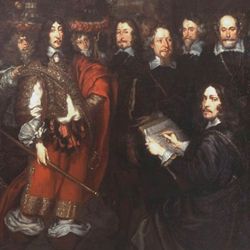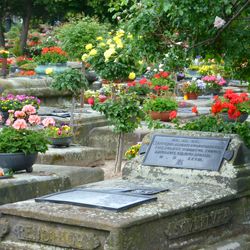Joachim d.Ä. von
Sandrart
painter, etcher, collector, art dealer,
born Frankfurt/Main, 18. May 1606
died Nürnberg, 18. Oct 1688
Grave no. C 3b in the Johannis cemetery, epitaph still present.
(...)
1619 first instruction in drawing by Sebastian Stoßkopf in Hanau. Further training with the engravers Theodor de Bry and Matthäus Merian the Elder in Frankfurt, with Daniel Soreau in Hanau, 1620 with Peter Isselburg in Nuremberg, 1622 with Egidius Sadeler in Prague. 1623-27 trained as a painter with Gerard van Honthorst in Utrecht. 1627 he stayed in London, 1628-35 in Venice, Bologna, Rome, Naples, 1635 in Frankfurt, 1638 until at least 1642 in Amsterdam. After the death of his father-in-law, he took over the inherited estate of Stockau near Ingolstadt in 1645, where he lived intermittently until 1670.
In 1649/50 he came to the Peace Congress in Nuremberg and was commissioned to paint the 'Peace Supper', which can probably be regarded as his main work of art.
(...)
For this work Sandrart received 2000 fl. rh. and a golden necklace with a royal bust worth 200 ducats from Count Palatine Carl Gustav of Zweibrücken (later King Charles X of Sweden). In 1670 he sold the Stockau estate and moved to Augsburg.
Around the turn of the year 1673/74 he moved to Nuremberg, where he took over the direction of the painters' academy founded in 1662. In November/December 1674, an "academi was set up in the Haus zur goldenen Rose at Josephsplatz 1, where Sandrart had already worked in 1649, so that people could practise the art of drawing".
(...)
His main literary work is the "Teutsche Academie der Edlen Bau-, Bild- und Mahlerey-Künste", 1st part 1675, 2nd part 1679, 3rd volume Ikonographische Schriften 1679/80, reprint in 3 volumes, Nördlingen 1994. The work is considered the first history of art in the German language, which was linguistically revised by Sigmund von Birken and other literary figures. In 1653 the emperor raised him to the peerage, and in 1676 he was admitted to the "Fruchtbringende Gesellschaft" (Order of the Palms).
In 1680 he acquired Albrecht Dürer's grave in the Johannis cemetery, which he had renovated and handed over to the care of the painters' academy. His stipulation that it "be left to him (Dürer) alone for glorious honours, and that no one else be placed in it for ever" was violated in three cases in the years 1811/19.
(...)
quoted from the Nuremberg Künstlerlexikon, edited by Manfred H.Grieb
Style: Baroque
Period: 17th c.

